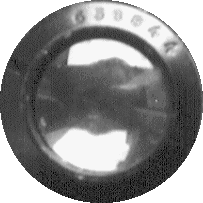Mar 17, 1996
This morning the postman brought me a box from London...
I opened the package (a successful bid at the March 3, 1996 Christie's Auction) and I found this rare lens mounted on an Exakta VX...

The engraved flange.

"MF", can anyone explain the meaning?
(Few days after this public question, Marc Small replied.)

On the inner lens there is the serial number with a little difference: on the front ring the number is 2658844 while in the rear ring there is not the first 2: 658844.

Marc James Small wrote:
Date: Thu, 07 Nov 1996 11:06:55 -0500
I can probably tell you a lot. What exactly are you asking? (I have a
deep interest in Wartime CZJ lenses and have written quite a bit on the
subject.)
Marc
Date:
Thu, 07 Nov 1996 11:19:59 -0500
Please disregard my earlier note: after sending it, I realized you were
suggesting that we look to your WEB page and did so.
First, this MAY be a fake: in the Postwar world, a LOT of fraudulently
marked 'wartime' gear has surfaced. This is much more common, however,
with Leica than with Zeiss, Zeiss Ikon, or Exakta.
Second, the Reichsadler and M probably indicate 'marine' or Naval use.
This is rather unusual: most German warships were equipped with Zeiss
Ikon Contax camera sets, none of which has ever surfaced in the Postwar
world to my knowledge.
The 'MF 655' is probably the contract number under which this lens was
purchased. These records were all destroyed in the final debacle of
Nazi Germany, but we are now getting a feel for the significance of some
of markings like this. There have been several articles run on this in
recent years in the Zeiss Historica Journal (and as a dedicated Exakta
collector, you should belong -- then you could buy the back issues and
read all about it!)
It was normal Zeiss procedure to use an abbreviated serial number on the
back of the lens. Thus, the '2' in yours has been dropped.
The serial number indicates production early in the War, probably in '41
or '42.
Please feel free to ask if I can be of further service.
Marc James Small
co-author, the Zeiss Compendium (Hove, 1995)
Vice-President, the Zeiss Historica Society
msmall@roanoke.infi.net
FAX: +540/343-7315
Cha robh bas fir gun ghras fir!
Date:
Fri, 08 Nov 1996 15:35:24 -0500
I have attached a file which lists information on joining the
Zeiss Historica Society.
Please note that our two Web
(the other one is here)
cites are noted, and I
would appreciate your linking these on your Exakta page. I am the E-Mail
contact.
A few more tidbits on this lens, which I have discussed with Charlie
Barringer, our President:
The "MF655" is a 'naval contract' number. It would seem that all Leica
cameras were purchased for military use through the Luftwaffe and all Zeiss
and Zeiss Ikon items through the Navy, thus even Zeiss Ikon cameras used by,
say, the Army would bear this "MF655" number. The American military uses a
similar procurement system today.
The meaning of the initial 'M' is disputed: this may indicate 'Marine" for
"naval" usage, or it may have some other meaning.
The lens ought to be an f/4.5 and not 3.5 as you indicate: this was the
only 'wide-angle' Exakta lens available before the War and was never very
common. (I have one quite similar to yours which was manufactured
immediately after the end of the War for the Contax S series: it will not
work on later M42 SLR's as it fouls the mirror.) This lens is rather rare
and yours, of course, is even rarer due to its military markings.
By the way, the presence of the Reichsadler does NOT make this a "Nazi"
Tessar: it was a German military lens, not a Party or Government optic.
Feel free to quote all or any portion of this and of my earlier post on your
Web page!
Marc
Note:
This page was made on 6th November 1996. The day after the first Marc's e-mail arrived. Two days after we knew the details about this lens. It's incredible!
Marc Small e-mail address
|

